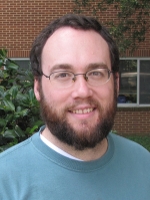Past NIMBioS Postdoctoral Fellow
Keenan Mack
 Dates: August 2012 – September 2014
Dates: August 2012 – September 2014
Project Title: Modeling the dynamics of mutualism in populations structured by limited dispersal
Keenan Mack (Ph.D. Biology, Indiana Univ., 2012) primarily focuses on how spatial processes, such as dispersal strategies, influence the population dynamics of plant and microbe interactions. Species interactions can be both negative in the form of competition, parasites or pathogens, and positive in the form of cooperation among or between species. Mack is interested in how negative feedbacks can explain broad patterns of diversity at the community level such as the observed correlation between average feedback and relative abundance as well as successional strategy in plant communities (e.g. Mack and Bever 2014).
Mack is interested in how positive feedbacks can explain the evolution of and maintenance of cooperation. For cooperation to be stable, often a population structure in which cooperative individuals interact more often with other cooperative individuals is required. At NIMBioS, Mack worked to include explicit resource utilization and incorporate multiple cooperative and non-cooperative species into spatial models of mutualism. Traditionally, these models use an increase in the reproductive rate, or a decrease in the mortality rate as the currency of the benefit paid during a cooperative interaction. However, when modeled in space these currencies also result in higher intensity local competition, which can inhibit the evolution of cooperation. Instead, Mack examines what happens when that benefit is paid in relaxed local density dependent population control, through for instance increased resource use efficiency, which is common among root symbioses (manuscript in prep). Mack will be following up on these theoretical explorations of the dynamics of cooperation with a postdoctoral position at the University of Miami with Dr. J. David Van Dyken working with experimental evolution in yeast (see Van Dyken et al. 2013).
LiveScience Profile Q&A with Dr. Mack: From selfishness to cooperation: What drives the change
NIMBioS Seminar: Spatial dependence of positive and negative species interactions
Video Interview:
The evolution of cooperation
Publications while at NIMBioS
Mack KML, Bever JD. 2014. Coexistence and relative abundance in plant communities are determined by feedbacks when the scale of feedback and dispersal is local. Journal of Ecology, 102(5): 1195-1201. [Online]
Magombedze G, Eda S, Stabel J. 2015. Predicting the Role of IL-10 in the Regulation of the Adaptive Immune Responses in Mycobacterium avium Subsp. paratuberculosis Infections Using Mathematical Models. PLOS One, 10(11): e0141539. [Online]
Van Dyken JD, Muller MJI, Mack KML, Desai MM. 2013. Spatial population expansion promotes the evolution of cooperation in an experimental prisoner's dilemma. Current Biology, 23(10): 919-923. [Online]
Bauer JT, Mack KML, Bever JD. 2014. Plant-soil feedbacks as drivers of succession: Evidence from remnant and restored tallgrass prairies. Submitted. Mack KML, Bever JD. 2014. Keystone competitors stabilize plant communities structured by biotic feedbacks: Invasion, coexistence, and robustness in multi-species models. Submitted.
Collaborations
Collaboration with J. David Van Dyken at University of Miami on a project that shows how spatial population expansion promotes the evolution of cooperation in an experimental Prisoner's Dilemma. Developed and wrote a spatially explicit computer simulation to compliment some experimental work and analytical theory. Found that because cooperative groups at the range edge were more productive than groups with non-cooperative individuals, they were more likely to found new groups. This recursive founder effect at the front can provide an environment that promotes cooperation. This work was published in Current Biology (2013).
Collaboration with Jonathan Bauer, Ph.D. candidate at Indiana University, and James Bever on a project that looks at how plant-soil feedbacks could generate patterns of succession. Developed and wrote the code for a spatial simulation that compliments some experimental work. Found that negative feedbacks in association with the basic colonization/longevity trade-off can explain observed patterns of succession in prairie systems. This manuscript has been submitted.
Working group/workshop participation:
Participant in the Plant-Soil Feedback Theory working group at NIMBioS
Education, Outreach and Training
Mentor for SRE at NIMBioS 2014
Volunteer for Summer Graduate Student Workshop
NIMBioS Interdisciplinary Seminar
Biology Departmental Seminar
Social/human Evolution Seminar
NIMBioS career development activities
NIMBioS
1122 Volunteer Blvd., Suite 106
University of Tennessee
Knoxville,
TN 37996-3410
PH: (865) 974-9334
FAX: (865) 974-9461
Contact NIMBioS


